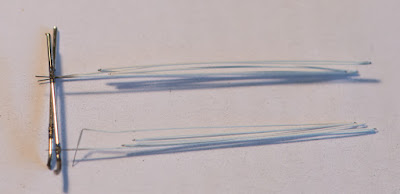Hi!
Sometimes when I am looking for a certain tube in my stash I stumble upon a type which I had forgotten about but which is interesting to show in the Tube of the Month series. Last time I rummaged through some tube drawers I came across the 6FY7.
The 6FY7 is a Compactron double triode with two dissimilar tube sections. Like many such dissimilar duo triodes it was developed for deflection and oscillator service in TV sets. But also for amplifier applications.
It has a 12 pin Compactron base which is shown on the left. The Compactron series of tubes was introduced by General Electric in the 1960ies as an attempt to integrate more functions into a single envelope. Hence the many base pins. Since the 6FY7 only contains 2 triodes not all of the pins are used which can be seen in the pinout diagram on the left. One of the unused pins, nr 8, is marked IC which stands for internal connection. This means nothing should be connected to that pin at the socket. Section 1 of the tube is a high mu triode with an amplification factor of 65 which comes with a plate resistance of a little over 40 kOhm. Section 2 is a low mu triode with an amplification factor of 6 and a low plate resistance of 920 Ohm. These parameters are
very similar to the 6FM7 which I presented already as tube of the month. So it would be useable in similar applications as the 6FM7. As the prefix 6 of the tube designation indicates the 6FY7 has a 6.3V heater. It needs 1.05A of heater current. Like most Compactron tubes the 6FY7 is largely ignored nowadays although it is still easy to find at low cost. Also Compactron sockets can still be found and are still made in China. A big drawback of the Compactron tubes is the difficulty to insert them into their sockets without bending the pins. Considerable force and care is needed. This is probably a reason for these tubes not being very popular. Let's have a look at the plate curves of the tube, first the high mu section:The curve set shows decent linearity especially useable for low level applications. Here the actual curves taken with the tracer:
The low mu section:
I only have 6FY7 tubes made by two different manufacturers. Let's start with one made by General Electric:
The typical all glass Compactron construction, in this case with a top getter.
 |























































